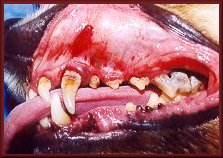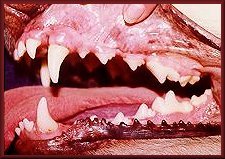|
Pet dentistry has become an established aspect of good veterinary care. And for good reason! One of the best things a pet owner can do to insure the overall health of their pet is to do routine checking of the teeth, gums and oral cavity. Look at the two photos below -- one shows a healthy state of oral hygiene, and the other ... well, you can see for yourself that this dog has some major problems. A healthy mouth with normal bacterial flora and sound gums and minimal plaque buildup. An unhealthy oral cavity with all sorts of unfavorable bacteria, gum and inner lip ulcerations, receding gums, root exposure and plaque buildup.The dog whose photo is on the right runs the risk of toxin absorption into the blood stream. Bacteria, too, can invade the body through the blood stream by gaining entrance into the oral lesions. This is called bacteremia. If the bacteria get a chance to settle and reproduce in the lining of the heart or heart valves, a serious condition may result called bacterial endocarditis. Kidney damage and joint problems are a common sequele to bacterial invasion via the unhealthy oral cavity. What Veterinarians Can Do: What if a seven-year-old dog was presented for annual vaccinations and during the physical exam the veterinarian notice the plaque on the teeth and inflamed gums at the margins of the teeth and gums? If left to its own evolution, the dog's gingivitis and plaque would worsen over time. The dog would eventually develop cavities in the teeth, gingival recession, bacterial contamination, loose teeth and root exposure. It probably would hurt, too! Typically, the dog would be admitted in the morning after an overnight fast from food and water. If the routine blood tests are normal and the dog is judged to be a good candidate for anesthesia and dentistry, we can begin. There are various pre-anesthetic sedation that are utilized, depending on the dog's size and the veterinarian's preference. After the dog is relaxed general anesthesia will be applied. This, too, can be in various forms. In this case, we will discuss using an endotracheal tube, which is regulated throughout the procedure so that work can be done painlessly and still have the patient at a safe level of anesthesia. An ultrasonic instrument is used to separate the plaque from the teeth. It sprays cooling water at the time it works it's cleaning magic on the teeth. After the teeth are "scaled" a light buffing is done to polish the teeth.
Often, an animal will need a root canal procedure performed or require a tooth to be capped. While many pet owners do not expect their pet to have these services performed, they can and should be done in certain circumstances. Gingival plastic surgery can be done, as well. Sometimes the best thing to do is to remove a severely damaged or markedly loose tooth. Once the gum heals, the pet seldom shows any signs of missing the offending tooth or teeth. As the dog awakens, the endotracheal tube is removed and antibiotics are prepared for administration at home for 7 to 10 days. Further instructions are given to the owner as to beneficial oral care for the dog. Hopefully s/he won't need further dentistry; but there are some patients who need ultrasonic cleaning almost every year. Be sure to take a good look in your dog's (or cat's) mouth and inspect it for any foul looking or smelling characteristics. If you are suspicious that something isn't right, make an appointment with your veterinarian for a dental checkup. Both you and your pet will feel better when oral hygiene is an important part of your pet health care routine. There is no excuse for allowing a pet's oral health status to deteriorate to conditions like the dog on the right. It's up to you to keep a look-out for teeth and gum problems.
0 Comments
Leave a Reply. |
The PAW Blog...
For the LOVE of Pets The goal of this blog is to help educate pet owners by sharing pet health facts and pet news articles...and ... sometimes put a smile on your face with a cute or funny pet story! Categories
All
Archives
July 2024
Search for any topic...
|



 RSS Feed
RSS Feed

